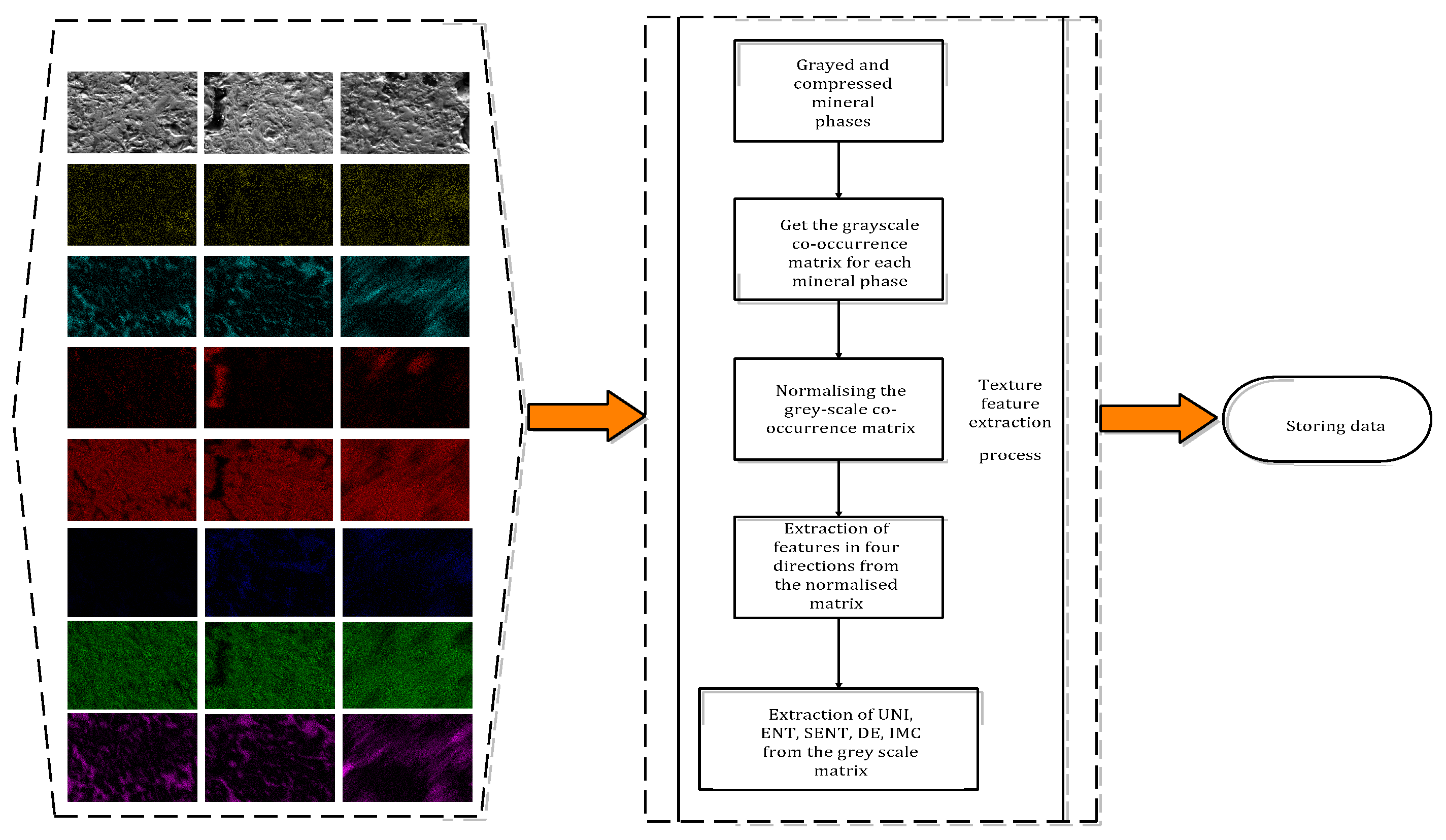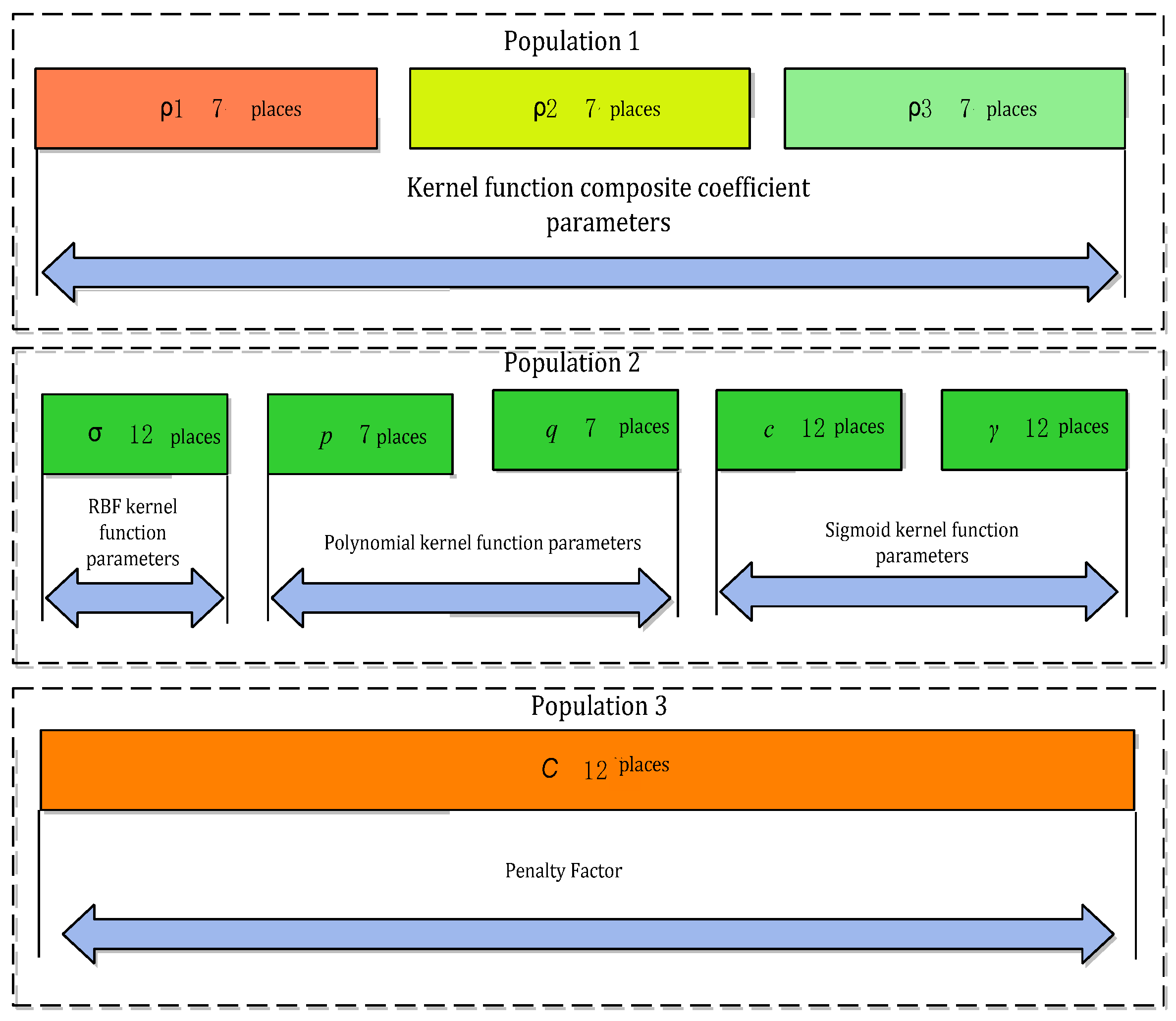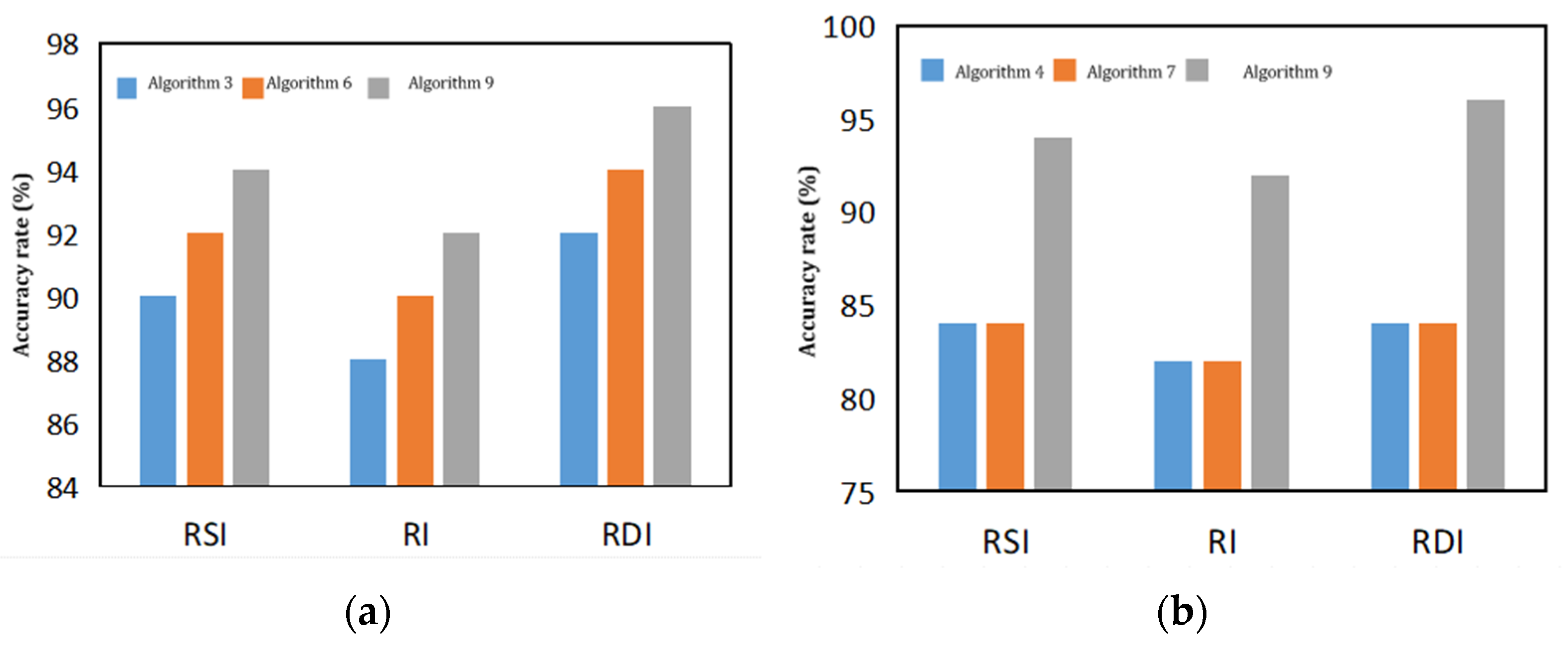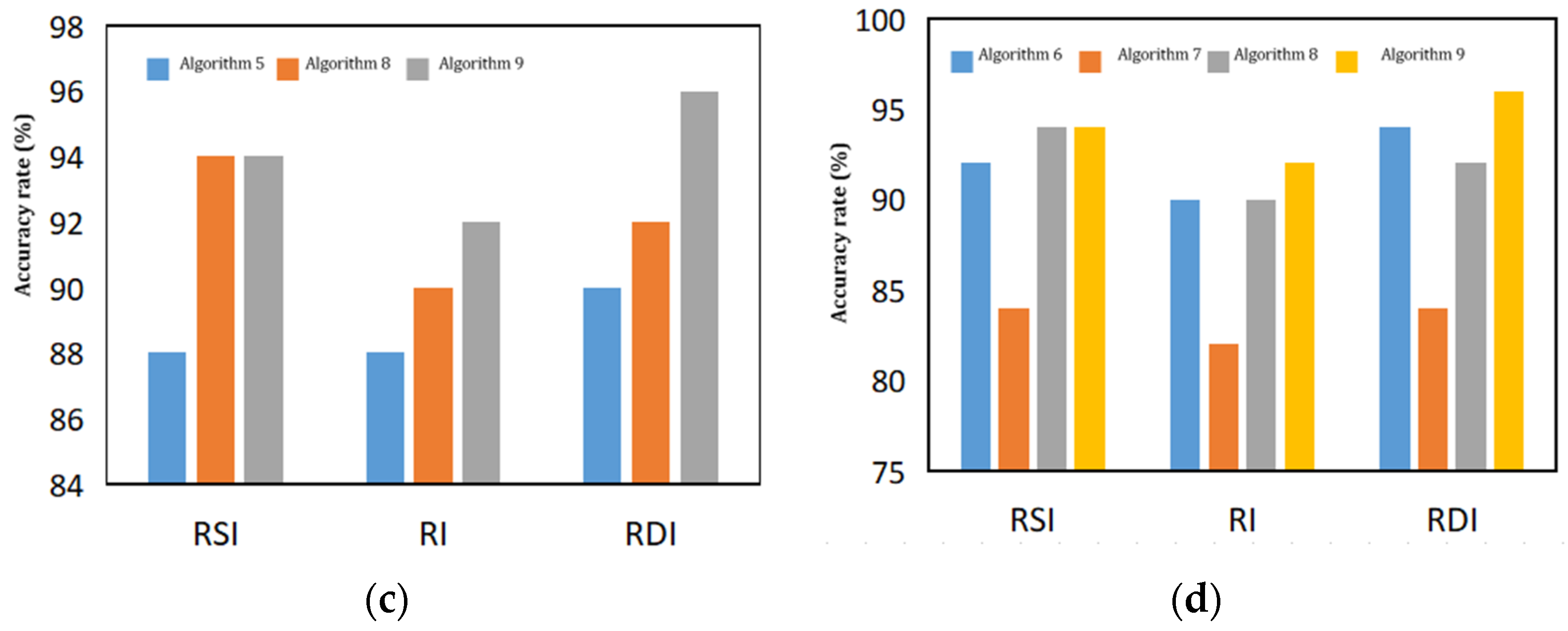Improved SVM Model for Predicting Pellet Metallurgical Properties Based on Textural Characteristics
Abstract
1. Introduction
2. Construction of the Sample Set
2.1. Extraction of Pellet Phase Characteristics
2.2. Integration of Sample Sets
3. Predictive Modeling of Pellet Metallurgical Properties
3.1. Related Knowledge
3.2. Forecasting Model Algorithm Design
4. Forecasting Model Simulation Experiments
4.1. Experimental Design
4.2. Simulation Analysis
5. Conclusions
Author Contributions
Funding
Institutional Review Board Statement
Informed Consent Statement
Data Availability Statement
Acknowledgments
Conflicts of Interest
References
- Gillespie, G.D.; Everard, C.D.; Mcdonnell, K.P. Prediction of biomass pellet quality indices using near infrared spectroscopy. Energy 2015, 80, 582–588. [Google Scholar] [CrossRef]
- Gillespie, G.D.; Everard, C.D.; Fagan, C.C.; McDonnell, K.P. Prediction of quality parameters of biomass pellets from proximate and ultimate analysis. Fuel 2013, 111, 771–777. [Google Scholar] [CrossRef]
- Abdollahi, M.R.; Ravindran, V. Influence of pellet length on pellet quality and performance of broiler starters. J. Appl. Poult. Res. 2013, 22, 516–522. [Google Scholar] [CrossRef]
- Karamchandani, A.; Yi, H.; Puri, V.M. Fundamental mechanical properties of ground switchgrass for quality assessment of pellets. Powder Technol. 2015, 283, 48–56. [Google Scholar] [CrossRef]
- Pomerantsev, A.L.; Rodionova, O.Y.; Melichar, M.; Wigmore, A.J.; Bogomolov, A. In-line prediction of drug release profiles for pH-sensitive coated pellets. Analyst 2011, 136, 4830–4838. [Google Scholar] [CrossRef] [PubMed]
- Dwarapudi, S.; Ghosh, T.K.; Shankar, A.; Tathavadkar, V.; Bhattacharjee, D.; Venugopal, R. Effect of pellet basicity and MgO content on the quality and microstructure of hematite pellets. Int. J. Min. Process 2011, 99, 43–53. [Google Scholar] [CrossRef]
- Bai, K. Research on Oxidation Roasting and Metallurgical Behaviors of Flux Pellets; University of Science and Technology Beijing: Beijing, China, 2022. [Google Scholar] [CrossRef]
- Dwarapudi, S.; Ghosh, T.K.; Shankar, A.; Tathavadkar, V.; Bhattacharjee, D.; Venugopal, R. Effect of pyroxenite flux on the quality and microstructure of hematite pellets. Int. J. Min. Process 2010, 96, 45–53. [Google Scholar] [CrossRef]
- Walker, C.T.; Kameyama, T.; Kitajima, S.; Kinoshita, M. Concerning the microstructure changes that occur at the surface of UO2 pellets on irradiation to high burnup. J. Nucl. Mater. 1992, 188, 73–79. [Google Scholar] [CrossRef]
- Han, Y.; Lv, Y.; Pan, Y.H.; Zhou, Q.; Yang, A. MComparison of SVM, BP Neural Network and Linear Regression. J. North China Univ. Sci. Technol. 2017, 39, 104–109. [Google Scholar]
- Lj, W.; Zy, Z.H.; Yl, L.; Yang, A.-M.; Han, Y. Study on Long and Short-term Memory Networks Model for Intelligent Recognition of Fitness Movements. J. North China Univ. Sci. Technol. (Nat. Sci. Ed.) 2022, 44, 114–120. [Google Scholar]
- Yang, A.M.; Han, Y.; Xing, H.W.; Zhang, Y.Z. Building SVM and PNN optimal classifiers based on GA-PLS algorithm and the application in infrared spectrum. Int. J. Adv. Media Commun. 2016, 6, 198–210. [Google Scholar] [CrossRef]
- Salimi, A.; Ziaii, M.; Amiri, A.; Zadeh, M.H.; Karimpouli, S.; Moradkhani, M. Using a Feature Subset Selection method and Support Vector Machine to address curse of dimensionality and redundancy in Hyperion hyperspectral data classification. Egypt. J. Remote Sens. Space Sci. 2018, 21, 27–36. [Google Scholar] [CrossRef]
- Han, Y.; Li, J.; Li, J.Z.; Xing, H.W.; Yang, A.M.; Pan, Y.H. Demonstration of SVM Classification Based on Improved Gauss Kernel Function. Adv. Intell. Sys. Comput. 2018, 613, 189–195. [Google Scholar]
- Yang, A.M.; Han, Y.; Han, C.C.; Xin, Z.C.; Liu, Z.C. Research on Evaluation of Landslide Hazard Based on Ant Colony Algorithm_Support Vector Machine Classifier. J. Comput. Nanosci. 2016, 13, 1117–1123. [Google Scholar] [CrossRef]
- Wahab, O.A.; Mourad, A.; Otrok, H.; Bentahar, J. CEAP: SVM-based intelligent detection model for clustered vehicular ad hoc networks. Expert. Syst. Appl. 2015, 50, 40–54. [Google Scholar] [CrossRef]
- Kazemian, H.; Yusuf, S.A.; White, K.; Grimaldi, C.M. NN approach and its comparison with NN-SVM to beta-barrel prediction. Expert. Syst. Appl. 2016, 61, 203–214. [Google Scholar] [CrossRef]
- Chai, H.Y.; Wee, L.K.; Swee, T.T.; Hussain, S. Gray-Level Co-occurrence Matrix Bone Fracture Detection. Am. J. Appl. Sci. 2011, 8, 26–32. [Google Scholar] [CrossRef]
- Vapnik, V.N.; Lerner, A. Pattern Recognition Using Generalized Portrait Method. Autom. Rem. Control 1963, 24, 774–780. [Google Scholar]









| Sample No. | Sample Input | Sample Output | ||||||
|---|---|---|---|---|---|---|---|---|
| UNI | ENT | SENT | DE | IMC | RSIGrade Labels | RIGrade Labels | RDIGrade Labels | |
| 1 | 0.5224 | 0.2592 | 0.6396 | 0.6707 | 0.9955 | 010 | 0 | 02 |
| 2 | 0.3994 | 0.4442 | 0.6485 | 0.1760 | 0.1385 | 001 | +1 | 01 |
| 3 | 0.3131 | 0.3336 | 0.9616 | 0.0556 | 0.4454 | 100 | 0 | 02 |
| 4 | 0.5254 | 0.0938 | 0.4998 | 0.3349 | 0.3580 | 010 | +1 | 02 |
| 5 | 0.0874 | 0.7117 | 0.1335 | 0.4594 | 0.6743 | 100 | −1 | 02 |
| 6 | 0.8858 | 0.5573 | 0.1561 | 0.0601 | 0.0777 | 010 | +1 | 01 |
| 7 | 0.9376 | 0.4101 | 0.1480 | 0.8545 | 0.5368 | 010 | −1 | 03 |
| 8 | 0.3379 | 0.4173 | 0.1989 | 0.7352 | 0.0657 | 001 | 0 | 01 |
| 9 | 0.3184 | 0.3425 | 0.9681 | 0.0626 | 0.4533 | 100 | 0 | 02 |
| 10 | 0.9974 | 0.1112 | 0.1313 | 0.4972 | 0.5242 | 001 | −1 | 02 |
| 11 | 0.8599 | 0.5826 | 0.4807 | 0.1739 | 0.8215 | 100 | 0 | 01 |
| 12 | 0.9418 | 0.3264 | 0.0271 | 0.8841 | 0.2348 | 010 | −1 | 02 |
| 13 | 0.4084 | 0.4503 | 0.6501 | 0.1814 | 0.1441 | 001 | +1 | 01 |
| 14 | 0.4540 | 0.8743 | 0.2006 | 0.8007 | 0.1423 | 001 | 0 | 03 |
| 15 | 0.3193 | 0.3423 | 0.9631 | 0.0647 | 0.4541 | 100 | 0 | 02 |
| 16 | 0.1222 | 0.1473 | 0.7659 | 0.1289 | 0.6511 | 010 | +1 | 03 |
| 17 | 0.3144 | 0.3382 | 0.9701 | 0.0617 | 0.4522 | 100 | 0 | 02 |
| 18 | 0.4506 | 0.4851 | 0.8568 | 0.0991 | 0.6068 | 001 | 0 | 02 |
| 19 | 0.9513 | 0.5520 | 0.0560 | 0.4916 | 0.0511 | 010 | −1 | 01 |
| 20 | 0.0187 | 0.3254 | 0.6100 | 0.6238 | 0.8563 | 100 | +1 | 02 |
| Algorithm Evaluation Parameters | Metallurgical Performance Indicators | Algorithm 6 | Algorithm 7 | Algorithm 8 | Algorithm 9 |
|---|---|---|---|---|---|
| (n ≦ 2000) | RSI | 220 | 1252 | 731 | 395 |
| RI | 275 | 2000 | 862 | 412 | |
| RDI | 322 | 1133 | 649 | 405 | |
| Q (%) | RSI | 8 | 16 | 12 | 6 |
| RI | 10 | 18 | 10 | 8 | |
| RDI | 6 | 16 | 10 | 4 | |
| P (%) | RSI | 92 | 84 | 88 | 94 |
| RI | 90 | 82 | 90 | 92 | |
| RDI | 94 | 84 | 90 | 96 |
Publisher’s Note: MDPI stays neutral with regard to jurisdictional claims in published maps and institutional affiliations. |
© 2022 by the authors. Licensee MDPI, Basel, Switzerland. This article is an open access article distributed under the terms and conditions of the Creative Commons Attribution (CC BY) license (https://creativecommons.org/licenses/by/4.0/).
Share and Cite
Han, Y.; Wang, L.; Wang, W.; Xue, T.; Zhang, Y. Improved SVM Model for Predicting Pellet Metallurgical Properties Based on Textural Characteristics. Metals 2022, 12, 1662. https://doi.org/10.3390/met12101662
Han Y, Wang L, Wang W, Xue T, Zhang Y. Improved SVM Model for Predicting Pellet Metallurgical Properties Based on Textural Characteristics. Metals. 2022; 12(10):1662. https://doi.org/10.3390/met12101662
Chicago/Turabian StyleHan, Yang, Lijing Wang, Wei Wang, Tao Xue, and Yuzhu Zhang. 2022. "Improved SVM Model for Predicting Pellet Metallurgical Properties Based on Textural Characteristics" Metals 12, no. 10: 1662. https://doi.org/10.3390/met12101662
APA StyleHan, Y., Wang, L., Wang, W., Xue, T., & Zhang, Y. (2022). Improved SVM Model for Predicting Pellet Metallurgical Properties Based on Textural Characteristics. Metals, 12(10), 1662. https://doi.org/10.3390/met12101662





